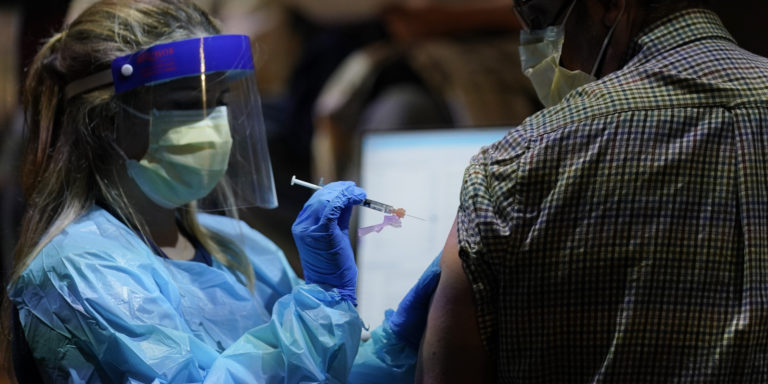INTELBRIEF
February 22, 2021
IntelBrief: The Quest for COVID-19 Vaccines Fuel a New ‘Arms Race’ between States

Bottom Line Up Front
- Now that vaccines have been developed and approved, delivering and administering effective doses has touched off an ‘arms race’ between states.
- Vaccine competition and public health diplomacy will be defining features of geopolitics in 2021.
- Appearing altruistic and benevolent in the distribution of vaccines is a unique soft power opportunity for countries like China, India, and the United States.
- Wealthier countries will need to donate and help distribute billions of vaccine doses to struggling regions, which is both a moral and practical imperative.
The international community is scrambling to limit the pace of COVID-19 mutations so that the vaccines currently being distributed and administered remain effective. This is accomplished by reducing the overall spread of the disease, and there are encouraging signs of progress in certain countries and regions. Unfortunately, progress has been fraught with setbacks and pitfalls. Many countries that manage to achieve a dip in the rates of infections and deaths, subsequently relax the very conditions that caused the initial drop, leading the cycle to repeat. The development of numerous vaccines is a remarkable achievement, both in terms of the time of development and production to the overall high efficacy rates in preventing infection and illness. The development and distribution of vaccines provide optimism that the cycles of infection can be broken, but the outcome is far from preordained. Getting these vaccines into the arms of billions of people is now the most pressing challenge for the international community. This is, in a manner of speaking, the ‘new arms race.’ Various countries are positioning themselves as public health superpowers, spurred on by the prestige afforded to those countries at the forefront of vaccine efforts. China previously adopted a strong role in supplying PPE and medical assistance to other countries as Beijing began to get control of the pandemic within China's borders, at a time when even U.S. states struggled to acces federal assistance.
Even before the current pandemic, India was a vaccine superpower, producing more than 60% of the world’s vaccines. Just one of its factories, The Serum Institute of India, produces 2.5 million COVID-19 vaccine doses a day. India is now using that capacity to assist countries throughout South Asia, by providing massive amounts of the COVID-19 vaccine to countries that would typically struggle to obtain them. But geopolitics is rarely altruistic, and it is important to recognize that by assuming a more proactive posture in vaccine distribution than China, India can expand its influence and foster goodwill with its neighbors. India has provided vaccines to Nepal, Bangladesh, Afghanistan, Sri Lanka and many other countries. New Delhi donated and delivered 50,000 doses to the Seychelles just a few weeks after China had donated and delivered 50,000 doses of their own vaccine. Recently, India also announced the supply of 200,000 vaccine doses for UN peacekeepers, among whom South Asian nationals are heavily represented. This competition will be a defining feature of geopolitics in 2021. Inevitably, some countries will seek to disrupt the process and rely on cyberattacks to gain access to the vaccine. Malevolent actors will seek to push anti-vaccine narratives on social media to destabilize countries through rampant health-related disinformation.
India, like many countries, is struggling to establish efficient vaccine distribution plans, which has resulted in surplus vaccines waiting to be distributed. India has a population of 1.2 billion people, and it will require immense effort to inoculate enough of its citizens to achieve ‘herd immunity’ and begin to knock the virus back. The U.S. is also struggling to get the vaccines to enough people, though it does appear to be improving in this regard. The U.S. has delivered at least one dose to 13 percent of the population, though it is important to keep in mind these vaccines require two doses, given several weeks apart. The delivery of vaccines that need to be kept at extremely low temperatures remains a challenge to rural distribution, though new variations requiring less extreme handling requirements and even single doses will soon be available. Harsh weather conditions across the country leading to power outages and the closure of major roadways have further complicated storage and delivery in the U.S.
Wealthier countries will need to donate and help distribute billions of vaccine doses to struggling regions. This is both a moral and a practical imperative. At the Munich Security Conference last week, President Biden announced that the U.S. would contribute $4 billion to COVAX and the WHO in support of global vaccine distribution. The pandemic has demonstrated in devastating clarity the interdependence of economies and communities from Detroit to Delhi. Already, governments have sought to garner influence by donating millions of vaccines bearing the name of their respective country. Unlike past ‘arms races,’ there is immense good to be gained by improving global health. The longer-term positive influence will be in those countries that can sustain these capacities, logistics, and supply chain infrastructure in preparation for the next global public health emergency. As with accelerating climate change, the international community must work in collaborative fashion so that future pandemics do not entirely destroy the global economy and leave millions sick and dying in their wake. So far, there is no evidence that malign actors like terrorists and other armed groups have sought to weaponize the virus, but as COVID-19 restrictions lift, the logistics and protocols developed through the vaccine distribution process should also enable governments to heighten security measures against such possibilities.